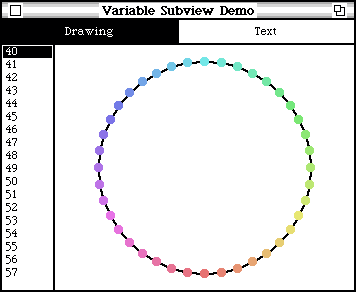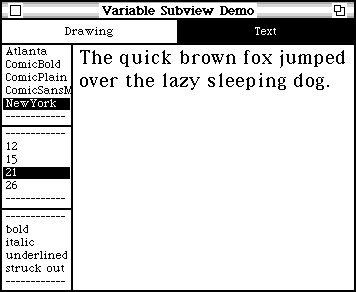This section explains how to program a window that replaces its subview with a different subview. On the top of the window we place two buttons to select the subview to be displayed. When the switch Drawing is pressed, the two subviews of a simple graphics demo are shown:

When the switch Text is pressed, the text style demo is shown:

The example reuses code from two previous examples.
The change set for this example is VariableViewDemo.1.cs. This change set is complete and independent from other change sets. You do not need to file in change sets of other examples.
For this example we need two auxiliary classes:
ActivationSwitch is a subclass of Switch that cannot be switched off by its controller.
Switch subclass: #ActivationSwitch
instanceVariableNames: ''
classVariableNames: ''
poolDictionaries: ''
category: 'MVCTutorial-AdvancedExamples
okToChange " a change is only allowed when the switch is currently off. " ^on not
The controller will send this message when you set the instance variable askBeforeChanging to true.
ContainerView is a view that has protocol to
The design of the subview follows the pattern of pluggable views: The view keeps a method selector which it uses
View subclass: #ContainerView
instanceVariableNames: 'subviewSelector'
classVariableNames: ''
poolDictionaries: ''
category: 'MVCTutorial-AdvancedExamples'
on: aModel subviewSelector: aSelector window: aRectangle
^self new
window: aRectangle;
setModel: aModel subviewSelector: aSelector
setModel: aModel subviewSelector: aSelector self model: aModel. subviewSelector := aSelector. aModel perform: aSelector with: self.
update: aParam
aParam = subviewSelector
ifTrue:
[self releaseSubViews.
model perform: subviewSelector with: self.
self display;
emphasize
]
The example itself uses the model
Model subclass: #VariableSubViewExample
instanceVariableNames: 'switch1 switch2 currentAspect'
classVariableNames: ''
poolDictionaries: ''
category: 'MVCTutorial-AdvancedExamples'
Variables switch1 and switch2 keep two instances of ActivationSwitch, the models of the two PluggableSwitchViews. The variable currentAspect keeps a message selector of a message that is sent to provide the subviews for a ContainerView.
An auxiliary method is used to create switch labels in a suitable style and size:
labelFor: aString
" create a DisplayText for the given string.
Change this method to display the switch labels
with a different text style or in a different size. "
| text textStyle |
text := Text string: aString attribute: TextEmphasis normal.
textStyle := TextStyle default copy.
textStyle defaultFontIndex: (textStyle fontIndexOfPointSize: 18).
^DisplayText text: text textStyle: textStyle.
This method is used twice in the open method:
open
"VariableSubViewExample open"
| topView model switch1 switch2 subviewContainer |
model := self new.
topView := ColorSystemView new.
topView label: 'Variable Subview Demo';
model: model;
borderWidth: 1.
switch1 := PluggableButtonView
on: model switch1
getState: #isOn
action: #switch.
switch1 label: (self labelFor: 'Drawing');
borderWidth: 1;
askBeforeChanging: true;
window: (0 @ 0 extent: 100 @ 15).
topView addSubView: switch1.
switch2 := PluggableButtonView
on: model switch2
getState: #isOn
action: #switch.
switch2 label: (self labelFor: 'Text');
borderWidth: 1;
askBeforeChanging: true;
window: (0 @ 0 extent: 100 @ 15).
topView addSubView: switch2
toRightOf: switch1.
subviewContainer :=
ContainerView
on: model
subviewSelector: #subViewAccessor:
window: (0 @ 0 extent: 200 @ 300).
topView addSubView: subviewContainer
below: switch1.
topView controller open
Here we create the models for the two switches and initialize the variable currentAspect. With the initial values that are used here, the window will be opened with the drawing.
initialize
switch1 := ActivationSwitch newOn
onAction: [self button1IsOn].
switch2 := ActivationSwitch newOff
onAction: [self button2IsOn].
currentAspect := #addGraphicView:
initialExtent ^500 @ 340
When a switch is turned on, it
button1IsOn switch2 turnOff. currentAspect := #addGraphicView:. self changed: #subViewAccessor:
button2IsOn switch1 turnOff. currentAspect := #addTextView:. self changed: #subViewAccessor:
These methods are needed to fetch the models for the two PluggableButtonViews.
switch1 ^switch1
switch2 ^switch2
Method subViewAccessor delegates the task to provide subviews for the requestor to one of the methods addGraphicView, addTextView:.
subViewAccessor: aViewContainer self perform: currentAspect with: aViewContainer
addGraphicView: subviewContainer GraphicalDemo2 addSubviewsFor: subviewContainer.
addTextView: subviewContainer TextStyleDemo addSubviewsFor: subviewContainer.
In TextStyleDemo, we have to add this class method:
addSubviewsFor: container
| model frame textView fontList fontSizesList attributesList |
frame := container window.
model := self new.
textView := PluggableTextView
on: model
text: #getText
accept: nil
readSelection: nil
menu: #getTextMenu:.
textView borderWidth: 1.
textView
window: (frame width *4 /20 @ 0 extent: frame width * 16/20 @ frame height).
container addSubView: textView.<
fontList := PluggableListView
on: model
list: #fontFamilyList
selected: #currentFontFamily
changeSelected: #selectFontFamily:
menu: nil
keystroke: nil.
fontList controller: (fontList defaultController
terminateDuringSelect: true);
autoDeselect: false.
fontList borderWidth: 1.
fontList
window: (0 @ 0 extent: (frame width * 4/20) @ (frame height / 3)).
container addSubView: fontList toLeftOf: textView.
fontSizesList := PluggableListView
on: model
list: #fontSizesList
selected: #currentFontSize
changeSelected: #selectFontSize:
menu: nil
keystroke: nil.
fontSizesList autoDeselect: false.
fontSizesList borderWidth: 1.
fontSizesList
window: (0 @ 0 extent: (frame width * 4 / 20) @ (frame height / 3)).
container addSubView: fontSizesList below: fontList.
attributesList := PluggableListViewOfMany
on: model
list: #textAttributesList
primarySelection: #listIndex
changePrimarySelection: #toggleListIndex:
listSelection: #listSelectionAt:
changeListSelection: nil
menu: nil
keystroke: nil.
attributesList borderWidth: 1.
attributesList
window: (0 @ 0 extent: (frame width * 4 / 20) @ (frame height/3)).
container addSubView: attributesList below: fontSizesList.
As far as it is now developed, this example has an annoying deficiency: A subview that is again selected, comes up with some initial settings, not with the settings that it had when is was replaced with another subview. It turns out that is deficiency can be fixed easily. This is what we will discuss in the next section.